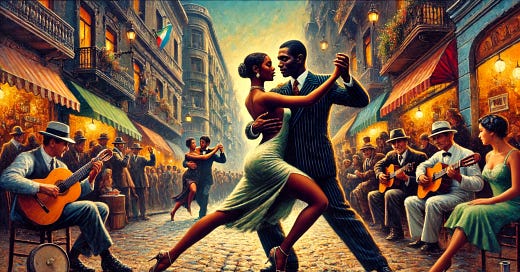Tango's Hidden Beat: Uncovering the African Roots of Argentina’s Iconic Dance
"How Afro-Argentine Rhythms and Culture Shaped the Passionate Pulse of Tango"
The Hidden African Origins of the Tango (episode. 2) 🎧
The tango, one of Argentina's most iconic cultural symbols, has deep African roots that have often been overshadowed by its European and Argentine elements. This dance, celebrated worldwide for its intense rhythms and intimate connection between dancers, owes much of its essence to the African rhythms and cultural traditions brought to Argentina by enslaved Africans. Here’s an exploration of the African origins of tango and how they influenced its evolution.
The Birth of Tango in Afro-Argentine Communities
Tango emerged in the 19th century in Argentina, influenced significantly by Afro-descendant communities. These communities, many of whom were brought to Argentina through the transatlantic slave trade, played a crucial role in shaping the cultural landscape, particularly through music and dance.
Afro-Argentine gatherings were commonly known as "tangos" and provided a space for Black communities to celebrate, connect, and preserve their cultural heritage. Within these gatherings, African-derived musical styles, such as the candombe and other traditional rhythms, became foundational to tango's development.
Over time, tango evolved from these spaces, drawing on various musical influences from African, Indigenous, and European traditions. The music and dance created in these communal gatherings would eventually become the tango known and loved today.
But wait, before you continue reading just wanted to say! I'm thrilled to introduce our new subscription service designed for passionate readers like you who are dedicated to deepening their understanding of Black history and culture.
🔹 For just $4.99/month, gain unlimited access to all our published current books, including the bestselling "Voice of the Ancestors" series.
🔹 First Access to any future books, ensuring you’re always at the forefront of new releases.
🔹 Over a thousand pages of insightful reading, supported by 500+ meticulously cited sources, providing a robust and credible educational experience anywhere, anytime.
🔹 Explore diverse and enriching topics such as the Moors, Indigenous Black Americans, Kemet, Mali, the Indus Valley civilization, and more.
✨ This is your chance to 🎓Earn a PhD-level education on Black history for the price of a cup of coffee! don’t miss out✨
African Rhythms at the Heart of Tango
Tango’s rhythm and movement, while seemingly European in structure, are deeply rooted in African musical aesthetics. One of the most important aspects of tango's rhythm—the "Kongo grind"—is a tribute to the dance forms from Central Africa, particularly from the Kongo region. This unique style combined African dance movements with European waltz-like steps, creating a blend that would later define tango’s unique embrace and style.
Even though tango famously lacks traditional African drums, which are often central to African music, African musicians found creative ways to integrate percussive elements. By adapting techniques on stringed instruments and the bandoneon (a type of concertina central to tango music), Afro-descendant musicians recreated rhythms reminiscent of African drumming. Techniques like the "arrastres" were introduced, where players dragged notes to create a rhythm that evoked the feel of African drum beats, adding an essential layer to tango’s heartbeat.
Influential Afro-Argentine Musicians and Composers
Several Afro-Argentine musicians contributed to the creation and popularization of tango:
Rosendo Mendizábal: Composer of "El Entrerriano," which is considered the first recorded tango piece, Mendizábal was instrumental in introducing tango to a wider audience.
Enrique Maciel and Leopoldo Thompson: These musicians, skilled in guitar, bandoneon, and double bass, were key figures in refining tango's unique sound. Their contributions helped shape the music that tango dancers moved to, embedding Afro-Argentine sounds into its core.
As tango gained popularity and became a symbol of Argentine identity, these contributions were often downplayed, and Afro-Argentine musicians were largely left out of the official narrative. The focus shifted to European influences, and the African roots were intentionally erased to align tango with Argentina’s self-image as a European-influenced nation.
The Revival of African Heritage in Tango
In recent years, there has been a growing interest in re-examining and honoring the African roots of tango. Documentaries and scholarly works have begun to shed light on the significant role of Afro-Argentine culture in shaping tango. These efforts underscore how African rhythms, dance movements, and instruments, though once hidden or dismissed, were foundational to tango’s creation and development.
Today, the recognition of tango’s Afro-Argentine origins not only enriches its history but also serves as a testament to the resilience and cultural contributions of Afro-descendant communities in Argentina. Embracing this history offers a fuller understanding of tango, connecting its passionate movements and deep rhythms back to the African influences that helped create one of the world’s most celebrated dances.
Voice of the Ancestors Volume I Reviews Get your eBook NOW and see what all the Hype is about ! ✊🏿🙌🏿










